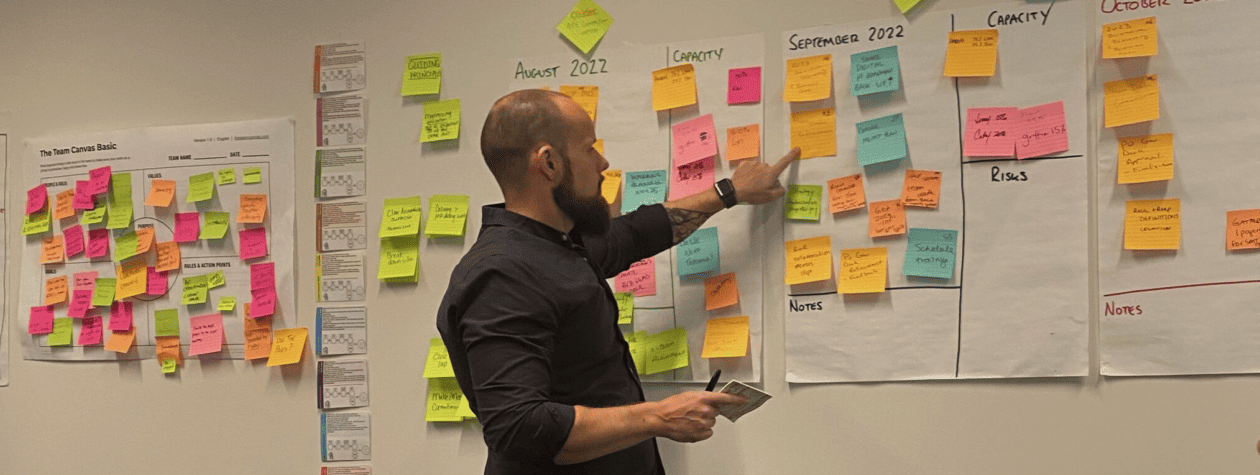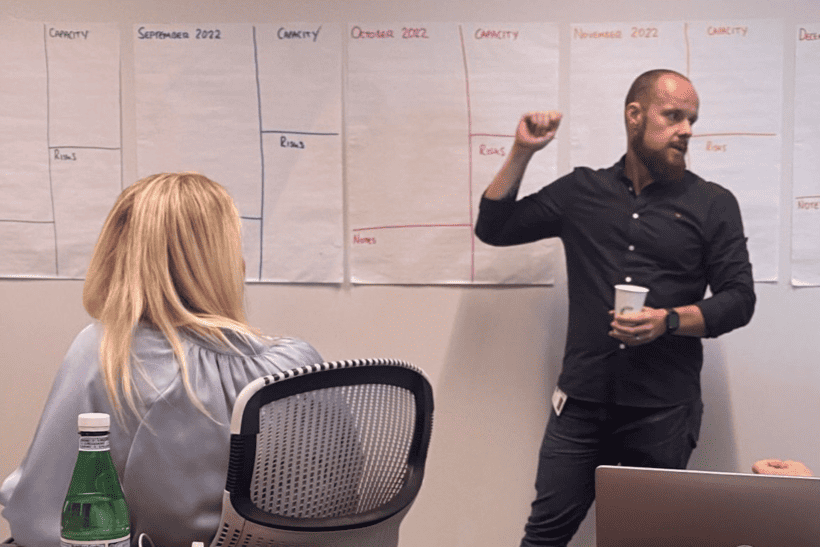Project Background
For over a year, McKenna Agile Consultants worked alongside our North American partner with a US charitable organisation to take their agile transformation to the next level by implementing SAFe Lean Portfolio Management (LPM) practices. This is the beginning of a new, 15-month LPM engagement.
The Challenge
Since early 2020, the digital and technology side of the organisation has led the way in terms of agile adoption to a significant degree of success. We had worked with the client to enable their digital ARTs to deliver predictably and effectively at the team and program level (at the most recent PI at the time of writing they had just achieved a 100% predictability measure for the first time).
The next challenge was to enable the rest of the organisation to move at the same pace as digital and technology. To begin with, we were asked to co-ordinate and collaborate closely with another consultancy on the initial LPM consultancy, assessment, and experimentation phases. Where a lot of companies would be hesitant to do this, we enjoy, and have a great track record of, collaborating with other consultancies.
Through these initial phases, several opportunities were identified:
- Improving alignment of Strategy and Execution
- Reviewing and redefining key roles and responsibilities in and around the key portfolio management processes
- Implementing a mechanism for objective prioritisation and adopting at a quarterly cadence
- Measuring throughput and flow across the portfolio
- Using forecasted capacity to implement rolling road-mapping
- Setting up a Portfolio Kanban to visualise all inflight initiatives
The Solution
Some of the key highlights of our LPM journey together were;
Partnering on the LPM Assessment and Initial Experiments
This phase consisted of the following two experiments:
- Reviewing the current prioritisation model and providing alternatives to explore, from RICE and 9 Box, to Weighted Shortest Job First (WSJF).
- Defining and piloting a new role specifically created to enable the alignment of strategy and execution
Launching the Dedicated Lean-Agile Center of Excellence (LACE)
We facilitated an in-person LACE kick off workshop to create our Team Canvas, aagree on our working cadence and build a high-level plan for the forthcoming quarter.
Delivering LPM Training
To gain greater alignment on the specific SAFe LPM processes and tools that we were adopting, we realised that we would benefit from delivering certified training to the LACE team, sponsors, and wider stakeholder group. This was delivered online and proved to be a major accelerator in upskilling the team and helping our change management efforts too.
“You really sparked a passion I didn’t know I had and paved the way for my future career – I’m excited!”
Senior Manager, Program Management
Optimising LPM Practices
A digital Portfolio Kanban was set up first. Visualisation of the portfolio began to add value immediately. There was an overabundance of initiatives that were work in progress (79 at the peak). This revelation enabled portfolio leaders to more actively engage with teams to address flow and embed a “stop starting, start finishing” mindset. The Portfolio Kanban has enabled the portfolio to dramatically reduce the amount of work in progress by 22%.
Value Stream Mapping
We used a Value Stream Mapping workshop to challenge some of our current states and assumptions, pulling forward ideas that could propel us toward our desired future state.

Applying Change Management Patterns
The LACE team by this point were delivering at a significant pace, which brought about its own set of challenges, specifically concerning change management. This led the LACE to bring in another member to the team, a dedicated change management practitioner. This new team member helped to focus the team’s communication with the wider organisation.
Using Prosci’s ADKAR model to guide us, we identified gaps and built a communication strategy around it. In addition, we held multiple employee and stakeholder interviews leading to the creation of 7 personas. These were then converted into a communication matrix based on David Rock’s SCARF model. This helped to focus on the “what’s in it for me” (WIIFM).
Extending Beyond the Portfolio
As we finished the engagement, other departments across the client began to approach the LACE to see if they too could adopt an agile approach to their work. To support this, we curated some bespoke, internal agile training that was taught to the senior management team and we rolled out specific training and workshops to individual departments.
Finally, for the client to be self-sufficient, we offered train-the-trainer coaching to some select LACE team members.
Outcomes
- Improved Portfolio Performance: The LPM transformation efforts led by McKenna Agile Consultants resulted in a remarkable 9% improvement in the portfolio performance.
- Reduced WIP: 3 months on from the end of the engagement, the client saw a 22% reduction of work in process (WIP) due to the processes implemented and the mindset shift of “stop starting, start finishing” beginning to materialise.
- Achieving 100% Predictability: The digital ARTs within the organisation achieved a significant milestone during the project. They reached a 100% predictability measure, demonstrating the success of the agile adoption efforts at the team and program levels.
Furthermore, as a result of the successful agile transformation, other departments within the client’s organisation expressed interest in adopting agile approaches. This extension of agile practices showcased the scalability and sustainability of the transformation efforts.
“This was one of the most challenging and rewarding engagements that I have been involved in. The level of enthusiasm from the people, the support from leadership and the focus on making the change stick were all instrumental in making this a success”
Aaron McKenna, Enterprise Transformation Director at McKenna Agile Consultants
Key Learnings
1. Understanding the greater vision
It is not enough that everyone is clear on the what we are doing, we need to ensure that everyone is even clearer on the why we are doing it. Using the “Cover Story” vision template, we were able to build a fun, engaging and compelling vision that brought everyone together to inspire change. This should be one of the immediate things that you do when starting any transformation effort.
2. Change management is essential to make the change stick
With smaller change efforts, you can manage change with sprint reviews. However, when you’re rolling out change in an organisation of hundreds and thousands, a more intentional approach to change is required, including tactics for managing resistance to change.
“In a large organisation, bringing a change to the cadence and getting the buy-in from employees is key to making changes stick … instrumental in helping us adopt a lean-agile mindset shift”
Digital Solutions Director, Client Organisation
3. Don’t underestimate the power of transparency
One of the simplest things that you can do TODAY to revolutionise how you work is to visualise your process and work in process. This will force you to confront the right conversations, and it send collaboration and alignment through the roof.
4. Remember that people come before the process
The Portfolio Kanban, Lean Business Cases and the other elements of LPM that you choose to adopt are great, but if your people do not know how they should engage and interact with the new processes, then you will fail to capitalise on some of the opportunities that adopting LPM will present. Start with your people, identifying the human side of change, understand the required behavioral changes and then work backwards to make your processes and tools fit.
Ready to adopt LPM?
This case study highlights the importance of clear vision, change management, transparency, and prioritising people over processes and tools. These insights can serve as valuable takeaways for other organisations considering similar agile transformations.
Get in touch today to learn how we can help to take your agile transformation to the next level.


